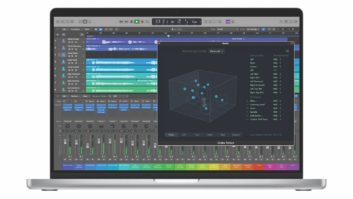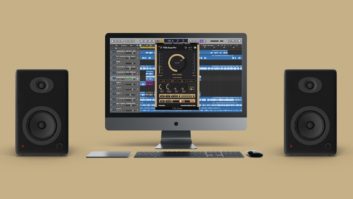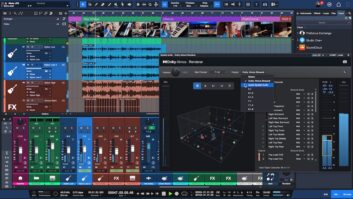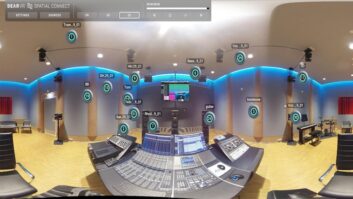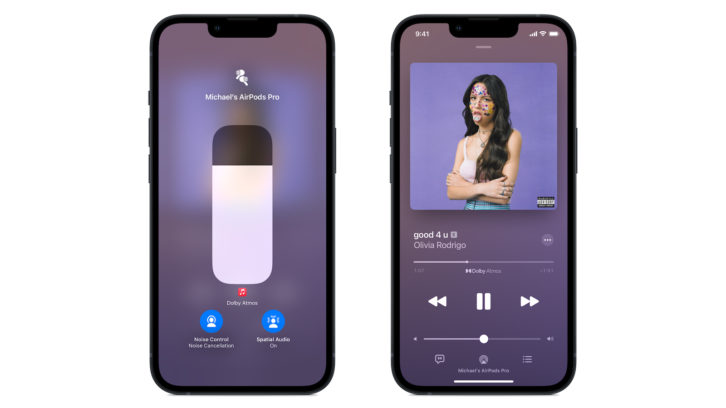
PHOTO: Courtesy of Apple
If you’re an independent artist or producer with no major label machinery to support you, how do you get your Dolby Atmos mixes onto the new Apple Music Spatial Audio streaming service for all to hear? While the artistic and mix talent is all in your hands, here are a few procedural items to be aware of before you start putting guitar in the height speakers.
Rendering to Binaural
The Dolby Atmos version of a song on Apple Music is streamed to consumers and rendered on-device for (non-AirPods and Beats) headphone listening in binaural audio, in a way that is optimized to preserve as much of the original immersive mix as possible. While the software that you use to create your Dolby Atmos mix can render a binaural version, Apple renders its own binaural version at the listening device. Because Apple does its own rendering, the mix might sound slightly different from the Dolby renderer..
Apple’s delivery spec calls for creators to deliver each song as an ADM Broadcast WAV file, at 48/24 and 24 fps, because the service needs all of the objects and metadata of the original Atmos mix in order to stream using the Dolby Digital Plus JOC (Joint Object Coding) codec. When delivered to a Dolby Atmos-enabled device, that song is rendered to 7.1.4 and then binauralized.
Apple Goes Spatial – Part 1: What’s It All Mean?
Apple does not accept upmixes from stereo masters on its platform. Apple also does not synthesize or upmix any song into the Dolby Atmos format, contrary to the rumors that spread online after the launch of Spatial Audio.
[Editor’s Note: That misinformation may stem from a switch in the Control Center in iOS labeled Spatialize Stereo. (This only shows up if using AirPods (3rd gen), AirPods Pro, or AirPods Max. If selected, this applies standard spatializing techniques to any stereo track to create a wider image and to direct ambience behind the listener, similar to the optional processing offered in any number of home and car entertainment devices.]
The Dolby Atmos software’s binaural render can still be useful, of course, enabling you to reference what listeners will hear while you are working on your mix—well, more or less. To preview what it will sound like on Apple Music you can export an .mp4 file from the Dolby Renderer and play it back from the Files app on an iOS device while using AiPods Pro or Max.
Upload: Atmos and Stereo
Once your Dolby Atmos mix is finished and appropriately exported, how do you deliver it to the Apple Music platform? The answer is the same way you send out your stereo tracks, through aggregators such as The Orchard, Distrokid, CD Baby and AvidPlay, which have all added support for Dolby Atmos material. Apple lists more than 15 such partners just for North America; ease of use and pricing may vary from one to the next.
When you upload your ADM BWF, you must also include the 2.0 stereo master, per Apple’s deliverables spec. Inside Apple this is referred to as the “intentional stereo” mix, because the service can alternatively create a stereo render—a downmix—from the ADM file if the appropriate checkbox is selected when uploading. (No one has yet requested this, Apple says, which shouldn’t come as a surprise.) When someone selects a song in Dolby Atmos, their device downloads the stereo master with it, allowing the listener to switch between the two versions.
Now With Headtracking
Listeners wearing Apple’s latest AirPods, including the Pro and Max versions (as well as the latest Beats model) can now experience an Atmos mix with dynamic headtracking. For those unfamiliar with the technology, headtracking can monitor the position of your head and reposition the mix in your headphones relative to it, so that it sounds as if you are listening to a fixed set of speakers in the room.
If Apple Music detects that a listener is on headphones without headtracking capabilities, it will instead send a binaural render, created server-side using the exact same processing described previously, to reduce bandwidth use. Certain Apple devices, including the latest MacBook Pro notebooks, can also play the immersive mix out of their built-in speakers. Apple updated its Apple Music for Android app in July, but so far Spatial Audio is available on only the handful of Android devices that are Dolby Atmos-enabled.
